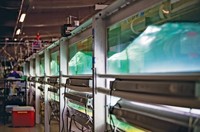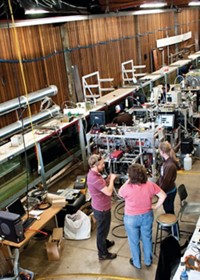Advertisement
Grab your lab coat. Let's get started
Welcome!
Welcome!
Create an account below to get 6 C&EN articles per month, receive newsletters and more - all free.
It seems this is your first time logging in online. Please enter the following information to continue.
As an ACS member you automatically get access to this site. All we need is few more details to create your reading experience.
Not you? Sign in with a different account.
Not you? Sign in with a different account.
ERROR 1
ERROR 1
ERROR 2
ERROR 2
ERROR 2
ERROR 2
ERROR 2
Password and Confirm password must match.
If you have an ACS member number, please enter it here so we can link this account to your membership. (optional)
ERROR 2
ACS values your privacy. By submitting your information, you are gaining access to C&EN and subscribing to our weekly newsletter. We use the information you provide to make your reading experience better, and we will never sell your data to third party members.
People
ACS Award For Creative Advances In Environmental Science & Technology
Sponsored by the ACS Division of Environmental Chemistry
by Cheryl Hogue
January 11, 2010
| A version of this story appeared in
Volume 88, Issue 2
Nearly two decades ago, when Kimberly A. Prather became interested in studying atmospheric aerosol particles, she planned to purchase an instrument for her new laboratory. She wanted a device to directly measure the size and chemistry of individual particles in the atmosphere.
When Prather conducted her initial search in 1991, she discovered there was no such instrument on the market.
As a newly appointed faculty member at the University of California, Riverside, she didn’t let that get in her way. She developed the aerosol time-of-flight mass spectrometer (ATOFMS) in-house. “There was clearly a major need for such an instrument,” says Prather, now a professor with a joint appointment in the department of chemistry and biochemistry and Scripps Institution of Oceanography at UC San Diego. Nonetheless, she tells C&EN, “it was tough getting the initial stages of funding” to develop the device.
Early reviewers of her federal grant proposals commented that Prather had made such an outstanding case for the need for such an instrument that they wondered why it hadn’t been invented yet. This, they concluded, might mean creation of the device was impossible, Prather says.
Eventually, however, she did receive federal support, and the ATOFMS was born. “Kim has developed an instrument that has pushed the boundaries of our understanding of atmospheric aerosols ahead by many orders of magnitude,” says aerosol scientist Mark H. Thiemens, dean of the division of physical sciences at UC San Diego.
ATOFMS provides information that can help investigators answer a host of questions about the atmosphere. These queries include what is the origin and chemistry of particles and how quickly do they change, which particles make up the majority of air pollution and affect human health, and which ones nucleate water drops or ice crystals and form clouds. Such investigations will help improve computer modeling of climate change and make predictions of future scenarios more certain.
But the applications of ATOFMS don’t stop with the atmosphere. The high-throughput mass spectrometry technique also finds applications in the chemical synthesis laboratory, scanning for reactants and products in real time, Prather says. It can also be used in the field to analyze water samples or soil extracts. And it holds potential for industrial applications such as checking the chemical purity of individual nanomaterials or powdered pharmaceuticals delivered via inhalers as aerosols.
Prather’s laboratory is currently exploring whether early cancer screening is possible with ATOFMS. Her team is calibrating the device to determine whether it can rapidly detect the few cancer cells in body fluids that are generally present years before tumors can be detected.
Prather, 47, received an undergraduate degree in chemistry at UC Davis and continued there to earn her Ph.D. in physical chemistry for studying photodissociation dynamics of organic molecules with lasers. She continued this research as a postdoc at UC Berkeley with Yuan T. Lee, a Nobel Laureate in Chemistry.
Prather will present the award address before the Division of Physical Chemistry.





Join the conversation
Contact the reporter
Submit a Letter to the Editor for publication
Engage with us on Twitter